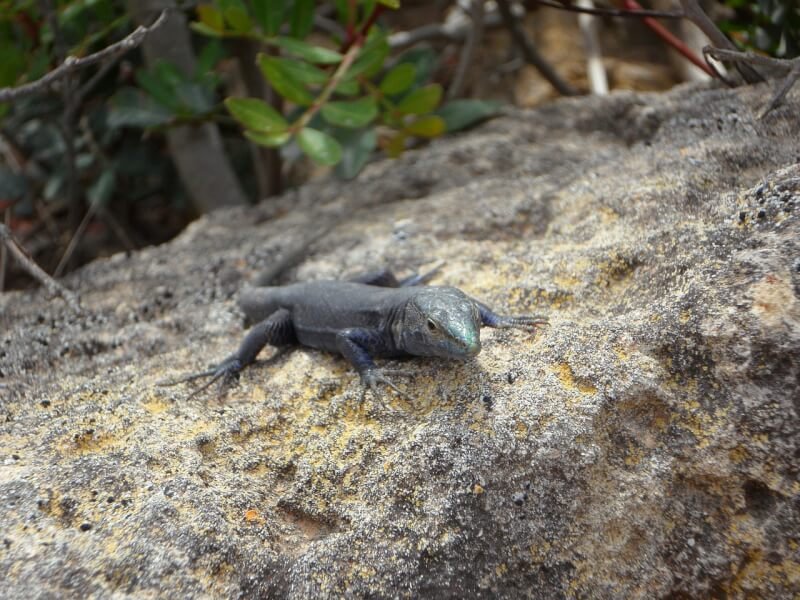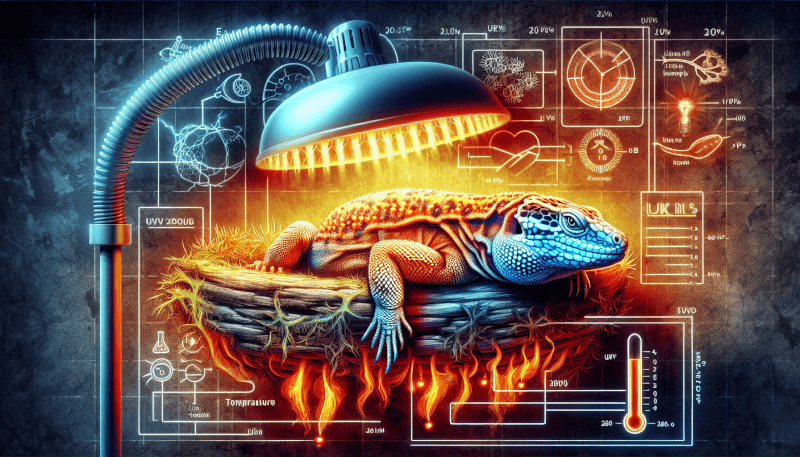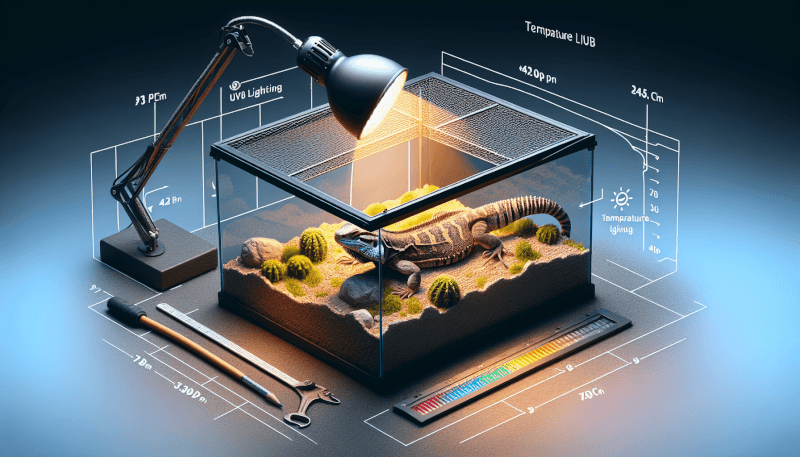Whether you’re a seasoned reptile enthusiast or a new reptile owner, choosing the right heating and lighting for your scaly companion is crucial to their health and well-being. The temperature and lighting conditions of their habitat can greatly impact their physical health, digestion, and overall behavior. In this article, we will guide you through the important considerations and factors to keep in mind when selecting the perfect heating and lighting setup for your reptile, ensuring they thrive in their environment and stay happy and healthy.

Factors to Consider
Type of reptile
When choosing the right heating and lighting for your reptile, the first factor to consider is the type of reptile you have. Different reptile species have different temperature and lighting requirements. For example, snakes are ectothermic and generally require warmer temperatures, while turtles and tortoises need a basking spot with UVB lighting to support their shell health. Understanding the specific needs of your reptile will help you make informed decisions about the heating and lighting options.
Natural habitat
Another important consideration is the natural habitat of your reptile. Reptiles have evolved to thrive in specific environments, and replicating those conditions in captivity is crucial for their well-being. Researching the natural habitat of your reptile will help you determine the optimal temperature and lighting requirements. For instance, if your reptile comes from a tropical rainforest, you will need to provide a higher ambient temperature and UVB lighting to mimic their native environment.
Behavioral needs
Reptiles have unique behavioral needs that should be considered when selecting heating and lighting options. Some reptiles are more active during the day, while others are nocturnal. Nocturnal reptiles like geckos and certain snake species will require lower-intensity lighting to simulate twilight or moonlight. On the other hand, diurnal reptiles like bearded dragons and iguanas need bright, full-spectrum lighting for optimal health and activity levels. Understanding your reptile’s natural behavior will help you create the right environment for them.
Size of enclosure
The size of the enclosure plays a crucial role in determining the heating and lighting requirements of your reptile. Reptiles need a temperature gradient within their enclosure to regulate their body temperature effectively. This means providing different temperature zones within the enclosure, including a basking spot, a cool zone, and a night zone. The size of the enclosure will determine the wattage and placement of heating and lighting equipment to ensure proper heat distribution throughout the habitat.
Budget constraints
While it’s important to provide the best possible care for your reptile, budget constraints can sometimes limit your options. It’s essential to consider the upfront and long-term costs of heating and lighting equipment. Some options may be more expensive upfront but offer energy efficiency and longer lifespan, which can save you money in the long run. Balancing your reptile’s needs with your budget will help you make practical choices without compromising their well-being.
Heating Options
Incandescent heat bulbs
Incandescent heat bulbs are a popular heating option for reptiles. They produce a warm, radiant light that helps maintain an elevated ambient temperature in the enclosure. Incandescent bulbs come in various wattages, allowing you to choose the right level of heat output for your reptile’s requirements. Additionally, they are relatively affordable and widely available, making them a convenient choice for many reptile owners.
Ceramic heat emitters
Ceramic heat emitters are another effective heating option for reptiles. These devices produce heat without emitting light, making them ideal for species that require darkness during the night or do not need additional lighting. Ceramic heat emitters are known for their longevity and durability, making them a cost-effective long-term heating solution. However, it’s important to use a ceramic socket with a built-in thermostat to avoid overheating.
Under-tank heaters
Under-tank heaters, also known as heat mats or heat pads, are placed underneath the reptile’s enclosure to provide warmth from the bottom. They are particularly useful for reptiles that require belly heat, such as snakes and certain lizards. Under-tank heaters create a warm surface for your reptile to rest on and help maintain proper digestion and metabolism. However, they should always be used in conjunction with other heating methods to create a temperature gradient within the enclosure.
Heat mats
Heat mats are an alternative to under-tank heaters and are commonly used for smaller enclosures like terrariums and hatchling setups. These low-profile heating pads are placed inside the enclosure, providing a localized heat source for your reptile. Heat mats are versatile and can be used to create a basking spot or a warm area within the enclosure. It’s important to use a thermostat to regulate the heat output and prevent overheating.
Heat tapes
Heat tapes are similar to heat mats but are more flexible and can be easily shaped to fit the contours of your reptile’s enclosure. They can be used to provide targeted heating to specific areas of the enclosure, such as the basking spot or hideouts. Heat tapes are easy to install and can be controlled with a thermostat to maintain the desired temperature. However, it’s crucial to use a heat-resistant material, such as heat tape insulation, to protect your reptile from direct contact with the tape.
Radiant heat panels
Radiant heat panels are a more advanced heating option that provides gentle, radiant warmth to the entire enclosure. These panels are energy-efficient and distribute heat evenly, creating a natural temperature gradient within the enclosure. Radiant heat panels are particularly beneficial for larger enclosures or habitats with multiple reptiles. However, they can be expensive upfront and may require professional installation, making them more suitable for experienced reptile keepers or those with larger budgets.
Choosing the Right Heat Source
Temperature requirements
Before selecting a heat source, it’s crucial to understand the specific temperature requirements of your reptile. Different reptile species have different temperature needs that must be met for their overall health and well-being. Research the optimal temperature ranges for your reptile and choose a heat source that can achieve and maintain those temperatures within the enclosure. Using a thermometer and thermostat will help you monitor and regulate the temperature effectively.
Size and shape of enclosure
The size and shape of the enclosure will determine the distribution of heat within the habitat. Larger enclosures may require multiple heat sources to create adequate temperature gradients and ensure uniform heating. Consider the dimensions and layout of the enclosure when choosing a heat source, and ensure that it can provide sufficient heat coverage to reach all areas effectively. Reflective surfaces or heat shields can also help redirect and retain heat within the enclosure.
Heat output
Different heat sources have varying heat outputs, which should align with the temperature requirements of your reptile. Some reptiles need a higher ambient temperature, while others require a localized basking spot with a higher heat output. Understanding your reptile’s specific needs will help you choose a heat source that can provide the appropriate level of warmth. It’s important to balance the heat output with the enclosure’s insulation and ventilation to maintain consistent temperatures.
Energy efficiency
Energy efficiency is an important consideration for both environmental sustainability and cost-effectiveness. Some heat sources, like ceramic heat emitters and radiant heat panels, are known for their energy-efficient operation. They convert more energy into heat and waste less energy as unnecessary light or heat dispersal. Choosing energy-efficient heat sources can help reduce your electricity consumption and save money on utility bills while still meeting your reptile’s heating needs.
Safety considerations
Safety should always be a top priority when choosing a heat source for your reptile. Ensure that the heat source you select is designed for reptile terrariums and enclosures. Avoid using household heating devices, as they may not be suitable or pose a risk to your reptile’s safety. Always use a thermostat to regulate the temperature and prevent overheating. Additionally, follow the manufacturer’s instructions for installation and maintenance to minimize the risk of accidents or equipment malfunction.
Lighting Options
Fluorescent tube lights
Fluorescent tube lights are a commonly used lighting option for reptile enclosures. They provide bright, full-spectrum lighting that mimics natural sunlight, promoting proper visibility, coloration, and plant growth. Fluorescent tube lights are available in various sizes and color temperatures, allowing you to choose the most suitable option for your reptile’s needs. They are energy-efficient, have a long lifespan, and are well-suited for diurnal reptiles that require high-intensity lighting.
Compact fluorescent lights
Compact fluorescent lights (CFLs) are a more compact and energy-efficient alternative to traditional fluorescent tube lights. CFLs provide similar benefits in terms of brightness, full-spectrum light, and color rendering, but they come in smaller sizes and are designed for different fixtures. CFLs are available in various wattages and color temperatures, giving you flexibility in choosing the right lighting for your reptile’s enclosure. They are especially useful for smaller enclosures or those with limited space for lighting fixtures.
Mercury vapor bulbs
Mercury vapor bulbs are a versatile lighting option that provides both heat and UVB lighting in one bulb. These bulbs are suitable for a wide range of reptiles and are particularly beneficial for species that require both basking heat and UVB exposure, such as bearded dragons and uromastyx lizards. Mercury vapor bulbs emit intense heat and UVB rays, making them an excellent choice for providing a basking spot and meeting the reptile’s lighting requirements. However, they can be more expensive and have a higher energy consumption compared to other lighting options.
LED lights
LED lights are gaining popularity in reptile lighting due to their energy efficiency and long lifespan. LED lights produce little to no heat and can be customized to emit specific wavelengths of light, including UVB and UVA. They are highly versatile and can be used for both diurnal and nocturnal reptiles. LED lights are available in various colors and intensities, allowing you to create the desired lighting environment for your reptile. Although LED lights can be more expensive upfront, they are cost-effective in terms of energy consumption and longevity.
UVB lights
UVB lights are essential for reptiles that require ultraviolet radiation for proper calcium metabolism and overall health. UVB lights come in the form of fluorescent tubes or compact bulbs specially designed to emit UVB wavelengths. It’s important to choose a UVB light that matches your reptile’s specific requirements, as different species have different UVB needs. UVB lights should be replaced regularly according to the manufacturer’s recommendations to ensure proper UVB output.

Determining the Right Lighting
UVB requirements
When determining the right lighting for your reptile, understanding their UVB requirements is crucial. UVB is important for reptiles to synthesize vitamin D3, which is vital for calcium absorption and healthy bone development. Different reptile species have varying UVB needs based on their natural habitat and behavior. Some reptiles require low to moderate UVB exposure, while others need high levels of UVB radiation. Research your reptile’s UVB requirements and choose a lighting option that provides the appropriate UVB output.
Diurnal or nocturnal species
Considering whether your reptile is diurnal or nocturnal will help you determine the right lighting duration and intensity. Diurnal reptiles, like bearded dragons and turtles, need bright, full-spectrum lighting for a significant portion of the day to support their natural activity levels and overall health. Nocturnal reptiles, such as leopard geckos and crested geckos, require lower-intensity lighting to simulate their natural environment and avoid disrupting their sleep cycles. Adjusting the lighting schedule and intensity based on your reptile’s behavior will promote their well-being.
Lighting duration
The duration of lighting plays a vital role in your reptile’s overall health. Mimicking natural lighting cycles is important for regulating their metabolic processes, sleep patterns, and reproductive behaviors. For diurnal reptiles, providing a light-dark cycle that closely resembles their natural habitat is essential. This typically involves keeping the lights on for around 10 to 12 hours a day and providing a period of darkness at night. Nocturnal reptiles, on the other hand, may require as little as 8 to 10 hours of low-intensity lighting during the day.
Lighting fixtures
Choosing the right lighting fixtures will ensure optimal performance and safety. It’s important to select fixtures that are compatible with the specific lighting bulbs you choose. Fluorescent tube lights require appropriate fixtures that can accommodate the length and wattage of the tubes. Compact fluorescent lights typically come with their own fixtures or adapters. Mercury vapor bulbs and UVB lights may also require specific fixtures or hoods that can handle the higher wattage and UVB output. Make sure to follow the manufacturer’s instructions when installing and positioning lighting fixtures.
Light intensity
The intensity of light should be considered when creating the ideal lighting environment for your reptile. Some reptiles, like desert-dwelling species, require higher levels of light intensity to mimic bright sunlight. Others, such as rainforest-dwelling species, thrive with moderate to lower light intensities. Balancing the intensity of light with the reptile’s natural habitat and behavior will help ensure their comfort and well-being. Use a light meter to measure the light intensity within the enclosure and make adjustments accordingly.
Combination Heating and Lighting Solutions
Heat and UVB bulbs
Heat and UVB bulbs offer a convenient solution for reptile owners looking to provide both heating and lighting in one bulb. These combination bulbs typically emit both UVA and UVB wavelengths along with heat. They are ideal for reptiles that require basking heat and UVB exposure, such as bearded dragons and certain turtle species. Heat and UVB bulbs come in various wattages and can be used in combination with other heating sources to create the desired temperature gradient within the enclosure.
Combination hoods
Combination hoods are lighting fixtures that accommodate multiple types of bulbs, allowing you to provide different forms of lighting simultaneously. These hoods typically have separate sockets for heat bulbs and UVB bulbs, providing flexibility to meet your reptile’s specific needs. Combination hoods are commonly used for larger enclosures or habitats with multiple reptiles that require different lighting requirements. They are available in various sizes and can be customized to accommodate different bulb wattages and types.
Multi-function fixtures
Multi-function fixtures are versatile lighting options that offer a combination of heating, lighting, and UVB capabilities. These fixtures are designed to incorporate different types of bulbs, such as heat bulbs, UVB bulbs, and fluorescent tubes, into one compact unit. Multi-function fixtures are particularly beneficial for reptile owners who want to provide a comprehensive lighting and heating solution while minimizing the number of individual fixtures. They are available in different configurations and wattages to suit various reptile species and enclosure sizes.

Temperature and Light Zones
Creating a basking spot
Creating a basking spot within the enclosure is essential for reptiles that require localized heat to regulate their body temperature. A basking spot should provide a higher temperature range compared to the rest of the enclosure, allowing your reptile to thermoregulate effectively. Use a basking bulb or ceramic heat emitter positioned over a basking platform or rock to generate the desired heat. Monitor the temperature using a thermometer placed at the basking spot to ensure it falls within the recommended range for your reptile species.
Providing a cool zone
Providing a cool zone within the enclosure is crucial to allow your reptile to escape from the heat and regulate their body temperature. This area should have a lower temperature range compared to the basking spot, allowing your reptile to cool down when needed. The cool zone can be achieved by placing heat sources at one end of the enclosure and ensuring the other end remains cooler. Thermometers placed in different areas of the enclosure will help you monitor the temperature gradient and ensure your reptile has a comfortable cool zone.
Establishing a night zone
Nocturnal reptiles require a night zone within their enclosure to simulate the natural darkness they experience in their native habitats. This area should be low in light intensity and provide a cooler temperature range compared to the basking and cool zones. Night zones can be created by turning off or dimming the daytime lighting and using low-intensity heat sources if necessary. It’s important to ensure that the night zone remains dark and quieter to promote natural sleep patterns and nocturnal behaviors.
Simulating natural lighting cycles
Reptiles, especially diurnal species, benefit from having a lighting cycle that mimics their natural environment. Replicating natural lighting cycles helps regulate their behavioral patterns, metabolism, and overall well-being. Using timers for the lighting fixtures can automate the light-dark cycles, ensuring consistency and reducing the chances of human error. Set the timers to turn on the daytime lighting in the morning and turn it off at night to provide a consistent lighting schedule that aligns with your reptile’s natural rhythm.
Monitoring and Controlling
Using thermostats and hygrometers
Thermostats and hygrometers are essential tools for monitoring and controlling the temperature and humidity levels within your reptile’s enclosure. Thermostats regulate the heat output of heating devices, allowing you to maintain a consistent temperature range. Ensure the thermostat is reliable and accurate, and follow the manufacturer’s instructions for proper installation and operation. Hygrometers measure the humidity levels in the enclosure, which can impact your reptile’s health and shedding process. Use a hygrometer to monitor the humidity and adjust it as necessary using misting or adding a humidifier if needed.
Automated temperature controls
Automated temperature controls offer a convenient and reliable way to regulate the temperature within your reptile’s enclosure. These systems typically consist of a thermostat connected to heating devices, allowing for precise temperature control. Automated temperature controls are programmable, allowing you to set specific temperature ranges and activate the heating devices accordingly. Some systems also feature alarms or alerts to notify you of any temperature fluctuations or equipment malfunctions, ensuring the safety and well-being of your reptile.
Timers for lighting
Timers are an essential tool for controlling the lighting schedule within your reptile’s enclosure. Lighting timers automate the on/off cycles of the lighting fixtures, eliminating the need for manual adjustments and reducing the risk of human error. Set the timers to provide the appropriate duration of lighting for your reptile, considering their diurnal or nocturnal behavior. Timers not only provide consistent lighting cycles but also ensure that your reptile receives the necessary periods of darkness, promoting natural sleep patterns and overall health.

Considerations for Specific Reptiles
Snakes
When it comes to snakes, heating and lighting requirements may vary depending on the species. Most snakes require an ambient temperature range of 75-85°F (24-29°C) with a basking spot temperature of 85-95°F (29-35°C). Heat sources such as under-tank heaters or heat mats placed on one side of the enclosure can provide belly heat, while incandescent heat bulbs or ceramic heat emitters can maintain the overall temperature. Snakes do not typically require UVB lighting, but providing a natural light-dark cycle is important for their well-being.
Lizards
Lizards have diverse heating and lighting needs that depend on their species and natural habitat. Diurnal lizards like bearded dragons and iguanas require high-intensity lighting, such as fluorescent tube lights or mercury vapor bulbs, along with basking heat sources. UVB lighting is essential for lizards to metabolize calcium properly. Nocturnal lizards like geckos and anoles may require lower-intensity lighting, such as compact fluorescent lights or LED lights, to simulate their natural environment while creating a day-night cycle.
Turtles and tortoises
Turtles and tortoises have specific heating and lighting requirements to support their shell health and overall well-being. Both aquatic and semi-aquatic turtles benefit from a basking spot with a temperature range of 85-95°F (29-35°C) provided by a heat bulb or ceramic heat emitter. UVB lighting is crucial for turtles to metabolize calcium and prevent shell deformities. Terrestrial tortoises also require similar temperatures and UVB exposure, but they may benefit from lower-intensity lighting during the night to simulate their natural environment.
Amphibians
Amphibians, such as frogs and newts, have unique environmental needs that differ from reptiles. They require specific temperature and humidity levels to support their aquatic or semi-aquatic lifestyles. Heat sources like heat bulbs or ceramic heat emitters can be used to maintain the desired temperature range within the habitat. However, amphibians do not generally require UVB lighting, as they obtain their vitamin D through their skin and diet. It’s important to research the specific requirements of your amphibian species and provide an appropriate lighting and heating setup accordingly.
Maintenance and Replacement
Cleaning and disinfecting
Regular cleaning and disinfecting of the heating and lighting equipment are essential for maintaining a healthy and safe enclosure for your reptile. Follow the manufacturer’s instructions for cleaning and maintenance to prevent the buildup of dirt, dust, or other contaminants that can affect the performance and lifespan of the equipment. Use reptile-safe disinfectants to clean the fixtures and remove any bacteria or fungi that may develop over time. Regular maintenance will help ensure the longevity and optimal functioning of the heating and lighting elements.
Bulb lifespan
The lifespan of heating and lighting bulbs can vary depending on the type and brand. It’s important to monitor the bulbs regularly and replace them when necessary to maintain the desired levels of warmth and light. Most heat bulbs, such as incandescent bulbs and ceramic heat emitters, have a lifespan of around 6-12 months. UVB bulbs generally need to be replaced every 6-12 months as well, as their UVB output diminishes over time. Monitoring the bulb’s output and following the manufacturer’s recommendations for replacement will support your reptile’s health and well-being.
Replacing old or damaged equipment
Over time, heating and lighting equipment may become old or damaged, affecting their performance and safety. It’s essential to regularly inspect the equipment for any signs of wear, such as frayed cords, loose connections, or malfunctioning thermostats. If you notice any issues or suspect that the equipment may be compromising your reptile’s safety, it’s important to replace it promptly. Investing in high-quality, reliable equipment and conducting routine checks will help ensure a safe and effective heating and lighting setup for your reptile.



